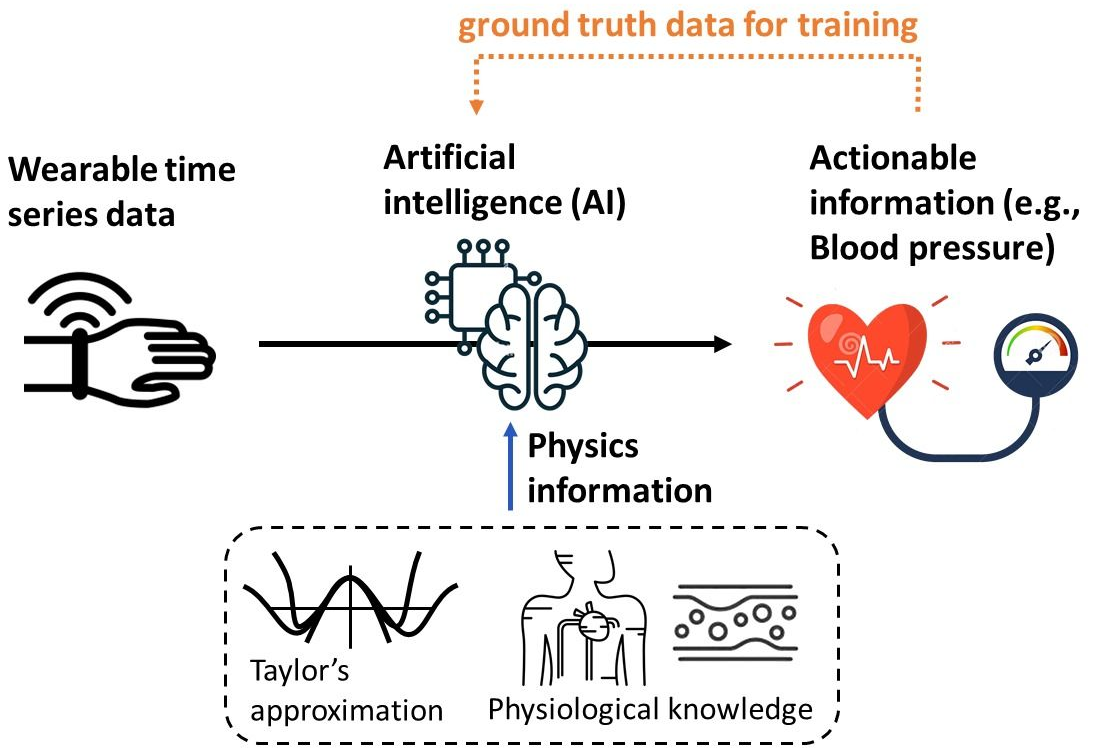Advancing Precision Medicine: Physics-Informed Neural Networks to Unlock Actionable Insights from Wearables
Published in Healthcare & Nursing
In the world of scientific research, every breakthrough begins with a question or a problem. In our case, the question was: "How can we better utilize AI in the realm of healthcare, specifically for physiological monitoring, without the dependency on large amounts of ground truth data?" This exploration has led us to a novel and exciting discovery - a unique implementation of physics-informed neural networks (PINN) for modeling wearable time series data and extracting actionable information such as blood pressure with high accuracy and reduced dependency on ground truth data.
Reduced Data Dependency for AI-based Modeling through Integrating the Underlying Physics
The existing AI algorithms in healthcare, while revolutionary, require significant amounts of ground truth data to extract complex cardiovascular information from measurements obtained with wearable sensors. This particularly becomes challenging for applications in precision medicine that are imposing personalization requirements, where models should be tailored to individuals based on their unique physiology. This, in many cases, necessitates the models to be trained with subject-level ground truth data collected from a large number of patients. Collecting this ground truth data at individual levels often requires the use of invasive or obtrusive medical-grade measurement systems (e.g., arterial line or cuff-based sphygmomanometer for peripheral BP monitoring), and therefore is challenging, burdensome, and in some cases infeasible.
As we navigated the complexities of AI in healthcare, we explored the opportunities of blending physiological knowledge for biological systems into AI. In essence, PINNs incorporate physiological laws into AI model training, reducing the amount of ground truth data needed. This is not without its challenges. Physiological knowledge often exists in relationships and constraints that cannot be accurately represented in closed-form equations. Hence the integration of the domain expertise on human physiology into AI model training is not trivial. Here, we propose a unique solution that uses the well-known Taylor’s approximation — a mathematical principle that simplifies complex functions — for certain gradually changing cardiovascular phenomena. This allowed us to establish relationships between physiological features extracted from sensor data (e.g., bioimpedance) and complex cardiovascular parameters (e.g., blood pressure).
We tested our proposed PINN implementation through a case study: estimating continuous, cuffless blood pressure from wearable bioimpedance sensor measurements. The results were impressive overperforming against all existing solutions that we tested. The PINN models maintained high correlations and low errors — indicative of accurate blood pressure estimations — while reducing the amount of ground truth training data needed by a factor of 15.

The Impact: Shaping the Future of Healthcare AI
Our journey, filled with questions and problems has led us to a unique discovery in the field of AI for healthcare. The PINNs present a new frontier for the application of AI in precision medicine and have vast implications from remote patient monitoring to the early diagnosis of cardiovascular diseases. The journey, however, doesn't end here. It's only the beginning of what we can achieve with PINNs. We believe that interdisciplinary research, combining fields of AI, computational modeling, and medicine will lead to innovative solutions. Our hope is that our work inspires further research, bringing us even closer to a future where physiological monitoring for personalized care becomes commonplace.
Follow the Topic
-
npj Digital Medicine

An online open-access journal dedicated to publishing research in all aspects of digital medicine, including the clinical application and implementation of digital and mobile technologies, virtual healthcare, and novel applications of artificial intelligence and informatics.
Related Collections
With Collections, you can get published faster and increase your visibility.
Artificial Intelligence in Emergency and Critical Care Medicine
Publishing Model: Open Access
Deadline: Jan 10, 2026
Evaluating the Real-World Clinical Performance of AI
Publishing Model: Open Access
Deadline: Jun 03, 2026




Please sign in or register for FREE
If you are a registered user on Research Communities by Springer Nature, please sign in